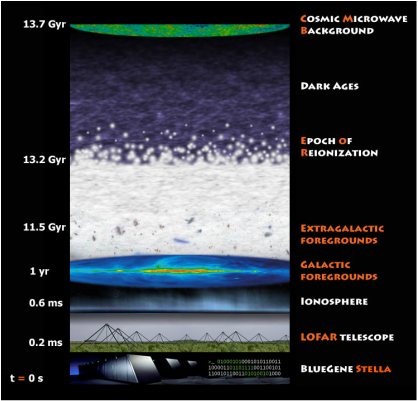I am an astrophysicist at the Kapteyn Astronomical Institute, Faculty of Mathematics & Natural Sciences, University of Groningen. My field of research is cosmology - the science that studies the Universe as a physical entity and explores its overall properties, formation and evolution. In particular, I work on various issues related to the formation and evolution of the Large Scale Structure of the Universe as probed by a number of astrophysical tracers (i.e., galaxy peculiar velocities, redshift galaxy surveys, Cosmic Microwave Background anisotropy, the Lyman-α forest observed in the spectra of distant quasars and the 21 cm hyperfine spin-flip transition of neutral hydrogen). Currently, my main scientific activity is centered on studying the Epoch of Reionization (EoR) of the Universe -- the period during which the gas in the Universe transformed from neutral to ionised. More specifically, I am a member of the LOFAR-EoR key Science project of the LOFAR radio telescope, which is the most promising instrument for studying this epoch.
- Cosmology and Structure formation in the Universe
Cosmology is the science that studies the Universe as a physical entity and explores its overall properties, formation and evolution. During the very early stages of its evolution the Universe went through a phase of very rapid expansion (inflationary phase), which has, among other things, created the initial fluctuations in the cosmological density field. These fluctuations have grown to generate the enormous amount of complexity and diversity we currently see around us.
My main interest in cosmology centres on the subfield that investigates the formation and evolution of the Large Scale Structure of the Universe. This is one of the most fundamental topics in modern cosmology. In order to understand the origin and evolution of the density fluctuations in the Universe, one has to address a wide range of topics. In my research I address the following fundamental questions: 1- What is the nature of the initial conditions from which structure has evolved? 2- What are the physical processes that govern the evolution of structure at each stage? 3- What is the connection of structure formation to the background cosmology and how this connection could be used? 4- What is the nature and amount of the dark matter and the dark energy − which are the dominant components of the energy-density − in the Universe? 5- When and how the baryons component (normal matter) have started playing a prominent role in structure formation in the Universe?
Due to the tremendous improvement in the theory, data analysis techniques and the amount and diversity of the accumulated information, a serious examination of these issues has become feasible. - The Epoch of Reionization of the Universe
(click here to download a semi-popluar article I wrote for European Physics News (2009))
The Epoch of Reionization (EoR) is a term used to describe the period during which the gas in the Universe went from being almost completely neutral to a state in which it became almost completely ionised. This watershed event - which has occurred when the Universe was a few hundred million years old (about a twentieth of its current age) and the first radiating objects formed - is intimately linked to many fundamental questions in cosmology and structure formation and evolution. Without a clear understanding of the EoR, we will not fully apprehend how the Universe evolved from its primordial condition to form the astrophysical object we routinely observe today.Despite its pivotal role, the EoR is one of the least understood epochs in the Universe's evolution. A large amount of theoretical effort, guided by very limited observational evidence, is currently dedicated to understanding the physical processes that trigger this epoch, govern its evolution, and what ramifications it had on subsequent structure formation. In the near future, the LOFAR telescope, which has the EoR as one of its key projects, is set to measure the neutral gas fraction in the Universe as a function of redshift and angular position through the hydrogen hyperfine spin-flip 21 cm line. The 21 cm line is, probably, the only observable tracers of the gas during the EoR. It allows detailed mapping the EoR as it progresses in time and space.
See my review on the topic that appeared in the book: The First Galaxies. Wiklind T., Mobasher B., Bromm V. (eds) Astrophysics and Space Science Library, vol 396. Springer, Berlin, Heidelberg
Cartoon of the likely development of the EoR. About 500,000 years after the Big Bang (z ~ 1000) hydrogen recombined and remained neutral for a few hundred million years (the dark ages). At a redshift, z ~ 10, the first stars galaxies and quasars began to form, heating and ionizing the hydrogen gas. The neutral intergalactic medium (IGM) can be observed with LOFAR through its redshifted 21 cm spin-flip transition up to redshift 11.5. However, many atmospheric, galactic and extragalactic contaminants corrupt the 21 cm signal
